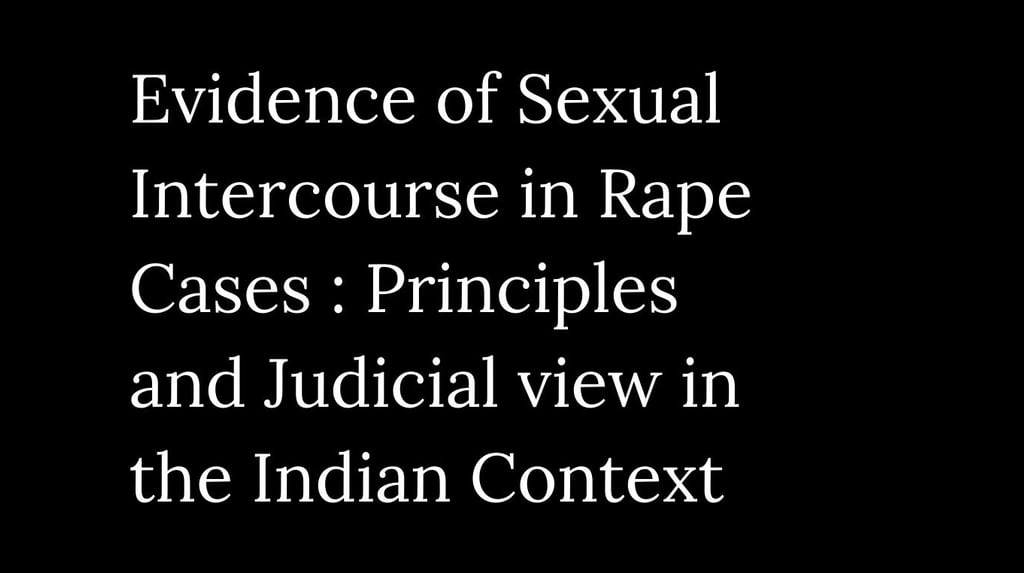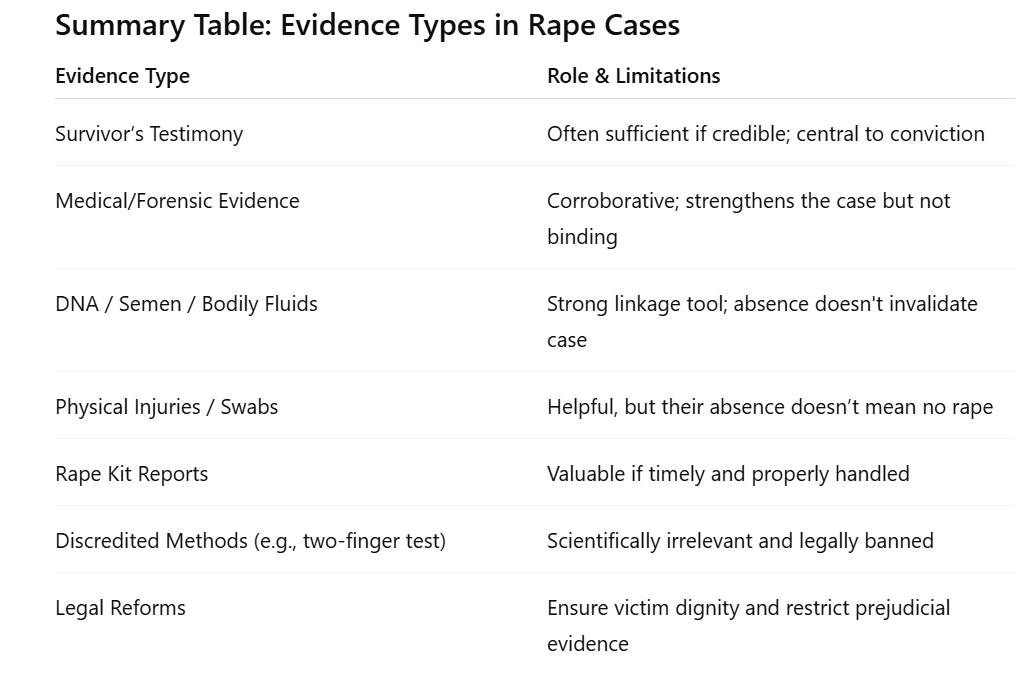Evidence of Sexual Intercourse in Rape Cases
Explore how Indian Courts consider medical evidence in rape cases to prove the occurrence or non occurrence of Sexual Intercourse with the help of decided cases, Legislative and Judicial point and FAQs
Author - THelawcritiQue
8/19/20256 min read


Evidence of Sexual Intercourse in Rape Cases: Principles and view of Indian Courts
Contents in the article :
Introduction
Legal Frame work under Indian Evidence Act, _ Section 114A and Section 45
Evolution of Indian Judiciary regarding Evidence of Sexual Intercourse in Rape Cases
Early Judicial Approach
Modern View
Key Case Laws
Conclusion
Key Highlights
FAQs on Evidence of Sexual Intercourse in Rape Cases
Introduction
This serves as one of the most important branches in criminal law which is 'rape trials' one of the most sensitive challenges before the courts. Unlike other offenses, where courts can rely on physical evidence which are straightforward, rape cases depend often on the establishment of one fact of "whether sexual intercourse occurred?" and, if so, "whether it was consensual?". So the first question to be decided in a rape case trail is whether sexual intercourse occurred?.
Historically, Indian Judiciary particularly in the branch of evidence placed heavy reliance on medical corroboration but over time, jurisprudence has shifted to recognize the testimony of the survivor as central evidence.
This article provides the critical examination of how courts approach the evidence of sexual intercourse in rape cases, the role of medical and forensic proof, and the evolving legal principles supported by landmark judgments.
Legal Framework under Indian Evidence Act
Section 114A: Presumption of Absence of Consent
The general rule of evidence is that presumption always lies in favour of the accused in criminal cases. But a special rule of evidence has been established particularly in the cases of rape under Section 114A of Indian evidence Act.
Section 114A of the Act provides that "where sexual intercourse by the accused is proved ant the question is whether it was without the consent ... if such woman states in her evidence before the court that she did not consent, the court shall presume that she did not consent" it means that if the victim asserts no consent in her evidence then court do not have an option but to presume there is no consent. Ultimately the burden of proving there is consent for sexual intercourse shifts upon the accused rather than the victim proving that she did not consent.
This again brings us to the first question - "whether sexual intercourse occurred?" the plain text of section 114A provides that "where sexual intercourse by the accused is proved" - that means for the court to presume no consent, the prima facie sexual intercourse has to be established in the first place.
Section 45: Expert Opinion
Section 45 of the Evidence Act permits opinion of experts such as doctors and forensic scientists. In every case of rape trail, the medical evidence plays most important role in concluding some of the vital questions of happening or non happening of events. While the section itself provides that Expert Opinion but Expert Evidence because an expert can form an opinion on scientific analysis based on the material evidences available but he is not an actual witness to the scene of offense. Thus, in numerous number of cases, the Courts have held that semen analysis, DNA profiling, and medical examination are valuable, but at the same time clarified that expert opinion is merely advisory and not binding.
Indian Courts have held that the medical evidence of the doctors or forensic experts can be used to corroborate the evidence of the prosecutrix, but they cannot solely decide event of occurrence of rape. In State of Punjab vs. Gurmit Singh, (1992 SCC (2) 384 where the court relied on the medical evidence to confirm that the sexual intercourse occurred.
In another instance in State of Maharashtra v. Chandraprakash Kewalchand Jain, (1990) 1 SCC 550) The Supreme Court held that a woman, who is the victim of sexual assault, is not an accomplice to the crime but is a victim of another person's lust and, therefore, her evidence need not be tested with the same amount of suspicion as that of an accomplice.
Evolution of Indian Judiciary regarding Evidence of Sexual Intercourse in Rape Cases
Early Judicial Approach
In the past, courts often acquitted accused persons for lack of medical corroboration, prioritizing physical proof over the survivor’s account. In Tukaram vs. State of Maharastra, famously known as Mathura Rape Case - the Court acquitted the accused on the consideration that there are no injuries or scars or any signs of protest on the body of the prosecutrix or the accused.
Also when the FIR was registered with delay and no trace of any medical evidence can be obtained, the courts favoured the accused and acquitted in many cases. Earlier courts insisted on semen detection or visible injuries as proof of rape. Several factors such as mismatching of semen samples, signs of injuries or protest used to confer a lot of weight on the prosecution witness to prove rape cases in India.
Reliance on the discredited “two-finger test,” and rupture of hymen was also widely criticized in the later stages. In Puran Chand v. State of Himachal Pradesh, 2014 (4) Supreme 122 (SC) - held that even non-rupture of hymen itself would be of no consequence and mere penetration is sufficient to prove the offense of rape. Such discredited practices were banned owing to repeated judicial rulings promising the dignity of the prosecutrix.
View of Apex Court : Modern view
Though trail courts occasionally relied on medical opinions and corroborative evidences, the Supreme Court reiterated the views of the trail courts and gave more weight to the witness of the prosecutrix. DNA profiling is now considered one of the most conclusive methods of linking the accused with the crime. However, mishandling of samples, delays in testing, or lack of infrastructure often weaken its evidentiary value. Which is why today, courts increasingly recognize the survivor’s testimony as sufficient. If her evidence is credible and trustworthy, conviction can be based solely upon it. This approach not only acknowledges the voice of the victim but also aligns with global human rights standards.
Key Case Laws
In Mukesh and Another v. State (NCT of Delhi) and Others (2017) 6 SCC 1 this landmark judgment, popularly known as the Nirbhaya Rape Case, the Court upheld convictions relying on medical reports, DNA evidence, and the dying declaration of the deceased victim. The case reaffirmed that rape trials must prioritize survivor dignity and reliable forensic methods.
In State of U.P. v. Pappu, (2005) 3 SCC 594 the Court held that even in a case where it is shown that the girl is a girl of easy virtue or a girl habituated to sexual intercourse, it may not be a ground to absolve the accused from the charge of rape. It has to be established that there was consent by her for that particular occasion. Absence of injury on the prosecutrix may not be a factor that leads the court to absolve the accused. This Court further held that there can be conviction on the sole testimony of the prosecutrix and in case, the court is not satisfied with the version of the prosecutrix, it can seek other evidence, direct or circumstantial, by which it may get assurance of her testimony.
Conclusion
Thus, judicial opinions on the law relating to evidence of sexual intercourse in rape cases has evolved significantly in India. From an era where medical corroboration was mandatory, courts now recognize that the victim's testimony, if credible, is sufficient for conviction. DNA evidence, medical opinion, and forensic proof remain important to prove the case of the prosecution but the absence of the same does not nullify the evidence of the victim.
Judicial sensitivity has transformed the approach from one rooted in suspicion to one grounded in dignity and fairness. While challenges in investigation and social bias remain, the legal framework today provides stronger protection to survivors and ensures that justice is not denied merely due to lack of physical evidence.
Key Highlights
Victim’s credible testimony is sufficient for conviction.
Medical and forensic evidence play a significant but not decisive, role.
Absence of semen or injuries does not imply consent.
Section 114A strengthens evidence of the victim by presuming absence of consent.
Opinion of the Experts can only be used for corroboration but not for acquittal.
FAQs on Evidence of Sexual Intercourse in Rape Cases
Is medical evidence mandatory to prove rape?
No. Medical evidence can support the prosecutrix but if the version of the prosecutrix is reliable and trustworthy, it alone can sustain a conviction.
Does absence of injuries mean consent?
No. Though initially expressed different views, the Supreme Court has repeatedly expressed that absence of injuries does not imply consent. Rape can occur without leaving physical marks.
What is the role of DNA testing in rape cases?
DNA profiling is one of the strongest forensic tools to connect the accused with the crime. However, due to delay in reporting or mismanagement of investigating authorities it is always prone weak impact. Which is why courts also does not wholly rely on DNA profiling and matching of semen samples.
Can a rape case succeed without semen detection?
Yes. In many cases information is reported with inordinate delay due to victims scared to open up about the incident. In which case no traces of any semen can be found. Absence of semen does not disprove rape. Even rape may occur without ejaculation in which case also relying on semen traces leads to injustice.


Connect With Us Through
Connect with us
© 2025. All rights reserved.
